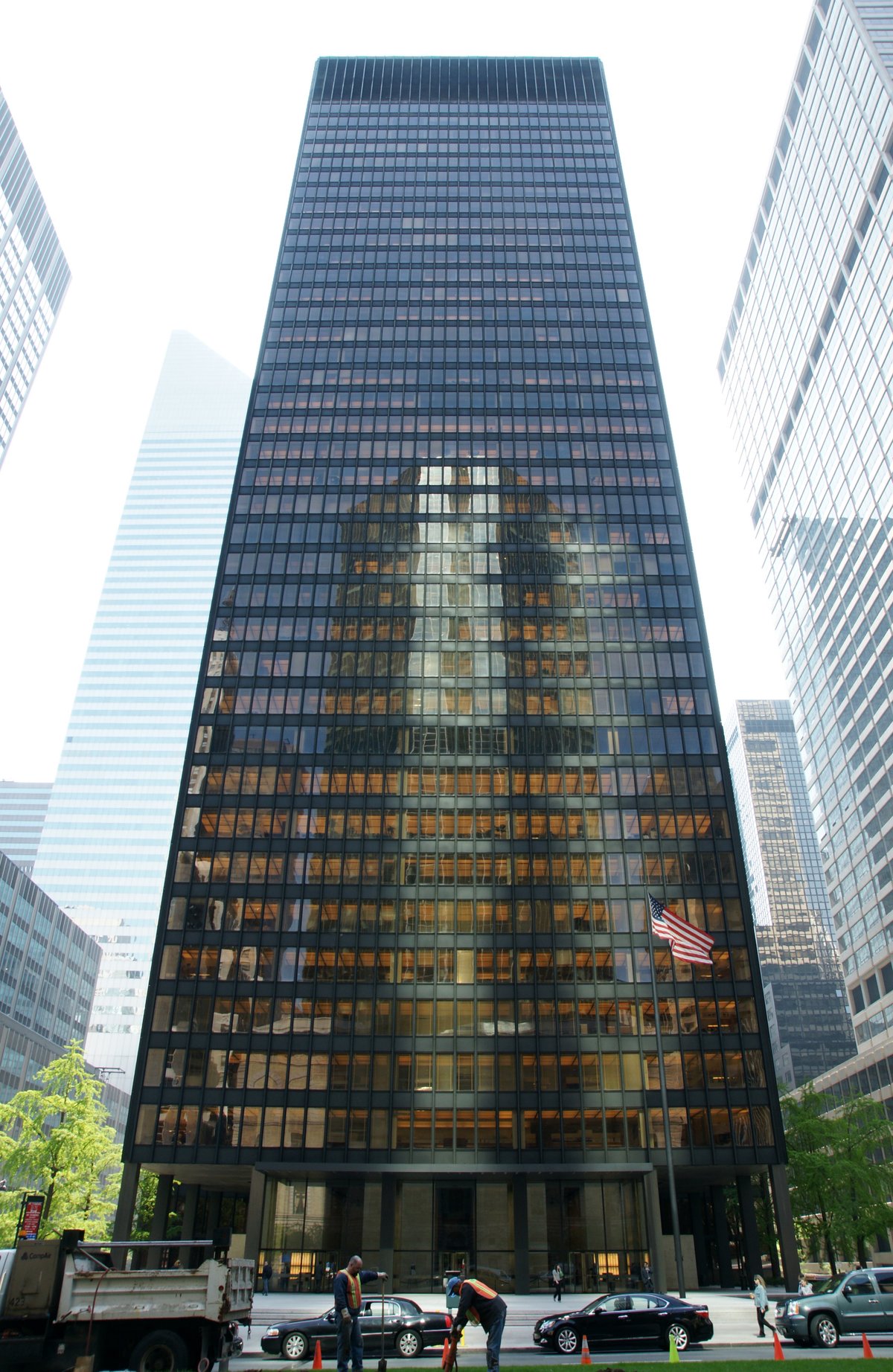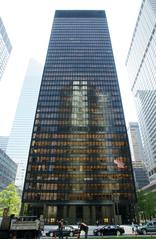
Seagram Building Visiting Hours, Tickets, and Travel Guide
Date: 14/06/2025
Introduction
Situated at 375 Park Avenue in Midtown Manhattan, the Seagram Building is a globally recognized icon of modernist architecture and urban design. Completed in 1958 and designed by Ludwig Mies van der Rohe with Philip Johnson, the building is celebrated for its minimalist International Style, elegant bronze-and-glass façade, and pioneering public plaza. Commissioned by the Canadian distilling company Seagram, with the crucial involvement of Phyllis Lambert, the building redefined corporate headquarters and set a benchmark for skyscraper design worldwide.
This comprehensive guide details the Seagram Building’s history, cultural significance, visiting hours, ticketing information, accessibility, nearby attractions, and travel tips to ensure a memorable and informative visit. (Architectural Review, Smarthistory, Britannica)
Table of Contents
- Historical Background
- Visiting the Seagram Building
- Frequently Asked Questions (FAQs)
- Conclusion
- References
Historical Background
Origins and Vision
The Seagram Building project was conceived as the flagship headquarters for the Seagram Company, then a leading Canadian liquor company. Samuel Bronfman and his daughter Phyllis Lambert were instrumental in commissioning a building that would both symbolize corporate modernity and contribute to architectural culture. Lambert, an architect herself, insisted on hiring Mies van der Rohe, ensuring the project had both creative vision and financial backing (Architectural Review, Smarthistory).
Architectural Innovations
Completed in 1958, the Seagram Building stands 516 feet tall with 38 floors. The design is noted for its use of a bronze curtain wall, decorative I-beams that visually express the building’s structural grid, and luxurious materials such as travertine and marble throughout the lobby and public areas. At a then-record cost of $41 million, its construction quality and attention to detail were unparalleled (Art Facts, Double Stone Steel).
Mies’s design principles—clarity, order, and “less is more”—are evident in the building’s proportions and the uniformity of its window blinds, which could only be positioned open, halfway, or closed, preserving the tower’s elegant exterior (Art Facts).
Urban Impact and Legacy
A major innovation was the building’s expansive granite plaza, set back from Park Avenue. This urban gesture broke the Manhattan street wall and provided a public open space, a rarity at the time. The success of the Seagram plaza directly influenced the 1961 New York City Zoning Resolution, which incentivized developers to provide publicly accessible spaces in exchange for greater building height (Scribd).
The building’s design, especially its use of glass, bronze, and open space, inspired generations of skyscrapers and remains a reference point for corporate architecture worldwide (Britannica).
Preservation and Recognition
The Seagram Building has been recognized as a New York City landmark since 1989 and is listed on the National Register of Historic Places (2006). Ownership has changed over the years, but its architectural integrity and historical significance have been meticulously maintained (Art Facts).
Visiting the Seagram Building
Hours and Entry
- Plaza: Open to the public daily, generally from 8:00 AM to 8:00 PM. The space is accessible for relaxation, photography, and architectural appreciation.
- Lobby: Accessible during business hours, typically Monday–Friday, 9:00 AM–6:00 PM. The lobby showcases Mies’s minimalist design with travertine walls and refined lighting.
- Interior Offices: Not open to the public; building functions as a private office tower.
- Tickets: No tickets or reservations are needed to access the plaza or lobby. Occasionally, architecture organizations offer tours that grant special access.
Accessibility
The plaza and lobby are wheelchair accessible with ramps and smooth granite surfaces. The building is within easy reach of accessible subway stations such as 51st Street (6 train) and 53rd Street–Lexington Avenue (E, M trains), as well as major bus routes.
How to Get There
- Address: 375 Park Avenue (between 52nd and 53rd Streets)
- Subway: E, M trains to 53rd St/Lexington Ave; 6 train to 51st St
- Bus: Multiple routes along Park Avenue and nearby streets
- Walking: The building is a short walk from MoMA, Rockefeller Center, and St. Patrick’s Cathedral
Nearby Attractions
Guided Tours
There are no official tours operated by the building itself. However, organizations such as the Municipal Art Society and the AIA New York Center for Architecture regularly offer walking tours that include the Seagram Building as a highlight. Special events like Open House New York occasionally provide opportunities for interior access (Scribd).
Photography Tips
For the best photographs:
- Visit during golden hours (early morning or late afternoon) for optimal light
- Use the plaza’s fountains and open space as foregrounds
- Capture details of the bronze façade and lobby interiors
- Be respectful of security and tenant privacy
Frequently Asked Questions (FAQs)
Q: Is the Seagram Building open to the public?
A: The plaza and lobby are accessible to visitors during business hours; other spaces remain private.
Q: Are tickets required?
A: No tickets or reservations are needed for the plaza or lobby.
Q: Are guided tours available?
A: No regular tours by the building, but architecture tours by external organizations often include the site.
Q: Is the building wheelchair accessible?
A: Yes, the plaza and lobby are accessible.
Q: What are the best nearby attractions?
A: MoMA, Rockefeller Center, St. Patrick’s Cathedral, Central Park, and Lever House.
Q: Are public restrooms available?
A: No public restrooms are available; plan accordingly.
Conclusion
The Seagram Building remains a quintessential symbol of modernist architecture and urban innovation, embodying the vision of Ludwig Mies van der Rohe and the foresight of its patrons. Its elegant bronze-and-glass façade, pioneering public plaza, and meticulous craftsmanship have left a lasting imprint on architectural practice and city planning around the world. While interior access is limited, the publicly accessible plaza and lobby provide an exceptional opportunity to engage with this masterpiece.
For the best experience:
- Visit during daylight hours for optimal views of the façade and plaza
- Consider joining an architectural walking tour for deeper insights
- Combine your visit with nearby cultural landmarks
For up-to-date information on special events, rare interior access, and audio guides, download the Audiala app and keep exploring New York City’s rich architectural heritage.
References
- Architectural Review
- Smarthistory
- Britannica
- Art Facts
- Double Stone Steel
- Scribd
- Hyperallergic
- Wikipedia
Images and interactive maps are recommended for enhanced exploration. Please use descriptive alt text such as “Seagram Building bronze facade - New York historical site” for SEO optimization.























































































































































































































































































